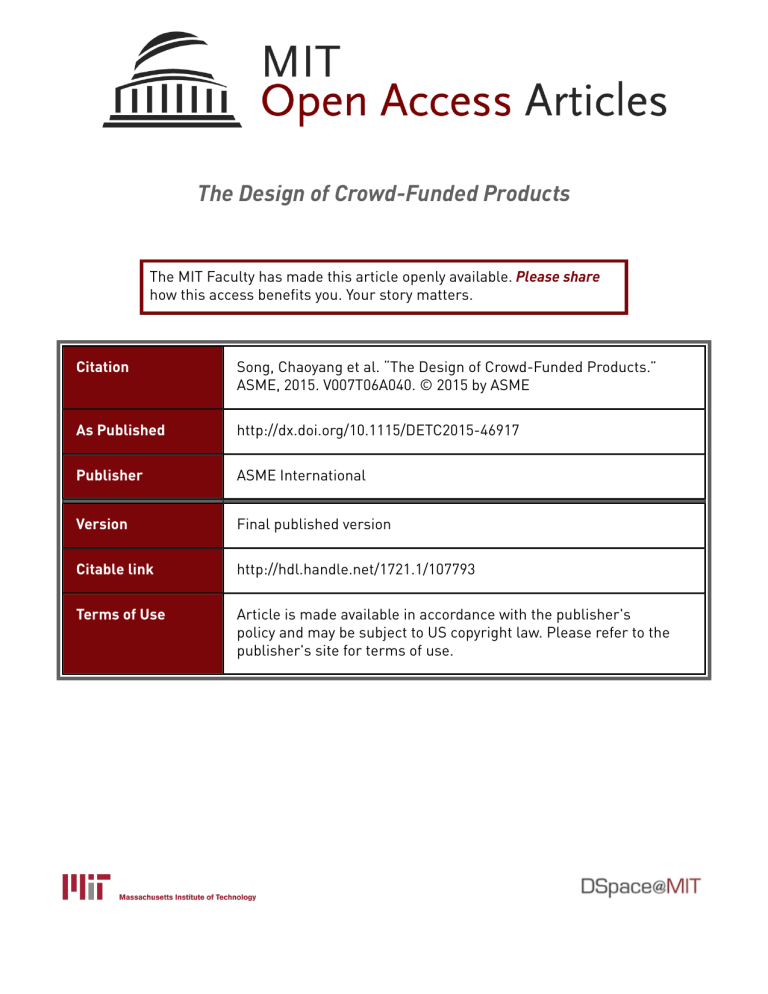
The Design of Crowd-Funded Products The MIT Faculty has made this article openly available. Please share how this access benefits you. Your story matters. Citation Song, Chaoyang et al. “The Design of Crowd-Funded Products.” ASME, 2015. V007T06A040. © 2015 by ASME As Published http://dx.doi.org/10.1115/DETC2015-46917 Publisher ASME International Version Final published version Citable link http://hdl.handle.net/1721.1/107793 Terms of Use Article is made available in accordance with the publisher's policy and may be subject to US copyright law. Please refer to the publisher's site for terms of use. Proceedings of the ASME 2015 International Design Engineering Technical Conferences & Computers and Information in Engineering Conference IDETC/CIE 2015 August 2-5, 2015, Boston, Massachusetts, USA DETC2015-46917 THE DESIGN OF CROWD-FUNDED PRODUCTS Chaoyang Song, Jianxi Luo, Katja Hölttä-Otto *, Kevin Otto Engineering Product Development Pillar Singapore University of Technology and Design Singapore, 487372 Singapore Email: chaoyang_song@sutd.edu.sg Email: luo@sutd.edu.sg Email: katja_otto@sutd.edu.sg Email: kevin_otto@sutd.edu.sg INTRODUCTION Crowdfunding is an emerging phenomenon that has attracted increasing attention, as many entrepreneurial designers have been able to collect significant development funding and validate user needs of their early concepts. In a typical crowdfunding campaign, small teams of product designers publish their ideas on a crowdfunding platform (CFP) such as Kickstarter or Indiegogo before completing the design. The designers are typically seeking for both financial support and user feedback to develop their proposed product concepts. Interested supporters review the product descriptions and, if interested, either make direct donations because of their interest in the design ideas, or pay in advance for an early version of the design. At best, therefore, they are investing in an early, underdeveloped product. Such activity would seem a natural venue for the design community to study early design activity, yet the knowledge about designing products to be successful on crowdfunding platforms remains limited. Crowdfunding significantly impacts the design process through creating new means of interactions between the designers (entrepreneurs) and the users (supporters) on the CFPs. For example, Pebble [1], an E-paper watch that runs dedicated software and works with iOS and Android devices through Bluetooth, successfully raised $10,266,845 from Kickstarter.com. With the funding raised, Pebble was able to complete the design process and deliver early prototypes to nearly 70,000 supporters. During the campaign, Pebble posted ABSTRACT Crowdfunding is an emerging phenomenon where entrepreneurs publicize their product concepts to raise development funding and collect design feedback directly from potential supporters. Many innovative products have raised a significant amount of crowdfunding. This paper analyzes the crowd-funded products to develop design guidelines for crowdfunding success. A database of 127 samples is collected in two different product categories from two different crowdfunding websites. They are evaluated using a design project assessment scorecard, the Real-Win-Worth framework, which focuses on the state of maturity on various customer, technical and supply chain dimensions. Our analysis identified key RWW factors that characterize successful design for crowd-funded products. For example, success at crowdfunding is attained through clear explanation of how the design operates technically and meets customer needs. Another recommendation is to not emphasize patent protection, for which crowd-funders are less concerned. Also, evidence of a strong startup financial plan is not necessary for crowdfunding success. These key RWW factors provide guidelines for designers and engineers to improve their design and validate their concepts early to improve their chances for success on crowdfunding platforms. KEYWORDS Product Development, Crowdfunding, Design Process * Warren Seering Department of Mechanical Engineering Massachusetts Institute of Technology Cambridge, Massachusetts, 02139 Email: seering@mit.edu Address all correspondence to this author. 1 Copyright © 2015 by ASME Downloaded From: http://proceedings.asmedigitalcollection.asme.org/pdfaccess.ashx?url=/data/conferences/asmep/86620/ on 03/27/2017 Terms of Use: http://www.asme.org/abo Figure 1. FROM LEFT TO RIGHT ARE SAMSUNG GEAR, MOTOROLA MOTO 360, APPLE WATCH, AND PEBBLE STEEL. IMAGE COPYRIGHT WITH HAJEK [2]. 53 updates to and received 15,629 comments from their supporters and kept them updated. Through these highly engaged interactions on Kickstarter, Pebble was able to quickly improve product design concepts and the design process, and promptly respond to supporters’ needs and expectations. With the funding raised for product development and manufacturing, Pebble significantly improved its watch hardware, software and service design, and successfully delivered the rewards, i.e. the preordered watches, to the many supporters. Pebble’s success also validated market demands for smart watches in general, which attracted many established companies to follow with similar products (see Fig. 1), including Samsung, Motorola, Apple, Sony, and others. In light of such cases, crowdfunding appears to be a new and important context for design research. The initial and most important research question for the design community might be how can a designer design products that can appeal to and successfully engage early adopters (users) to provide financial support and feedback/validation on a product concept. In this study, we aim to explore product design guidelines for crowdfunding successes through the empirical investigation of the design of crowd-funded products. Section 2 reviews past literature and establishes the association between crowdfunding and the major research areas of design process. Section 3 introduces the data of 127 crowdfunding product samples and the adapted metric of RealWin-Worth framework. Major results are summarized in Section 4, where comparative analysis is conducted between the products that reached their funding goals and those that did not. Section 5 concludes the paper. Figure 2. SCREENSHOT OF THE TOP 4 MOST FUNDED TOTAL 73,551 CAMPAIGNS AMONG KICKSTARTER’S CAMPAIGNS. crowdsourcing to evaluate a perceptual design attribute and to create new design concepts using this attribute. Further design insights were explored when applying machine-learning methods to generate design concepts using crowdsourced input. Researchers are also reaching out to the existing online design communities for novel design insights. In a recently study, Fuge and Agogino [5] investigated the trend of online community interactions and its impact on the design process through the case of OpenIDEO, an open innovation design community. One of their key findings with OpenIDEO concerns the use of community managers and incentives to promote an efficient network for generating new ideas while fostering cohesive collaboration groups. Fuge and Agogino [6] also analyzed the HCD Connect, an online design case study repository run by IDEO, and investigated when and how designers apply different design methods in unfamiliar contexts. They found that LITERATURE REVIEW A recent stream of data-driven design studies aims to analyze the data generated from online designer or user communities to explore guidelines to inform design decisionmaking. For instance, Burnap, et al. [3] introduced a Bayesian network model capable of identifying the crowd’s knowledge, which could be applied to the crowdsourced evaluation of design concepts. By using this model, those with higher design evaluation abilities could be effectively identified from the rest of the crowd. Ren, et al. [4] further explored the use of 2 Copyright © 2015 by ASME Downloaded From: http://proceedings.asmedigitalcollection.asme.org/pdfaccess.ashx?url=/data/conferences/asmep/86620/ on 03/27/2017 Terms of Use: http://www.asme.org/abo other similar products failed to reach their funding goals. We also include them for comparison. The resultant dataset has 127 products, including 47 3D printers and 23 smart watches from Kickstarter, and 31 3D printers and 26 smart watches from Indiegogo. This resultant dataset is collected through an exhaust search of both products on both platforms. A manual review is conducted to remove invalid samples, including those with insufficient data or simply asking for money with just an idea. A summary of the final dataset is provided in Tab. 1. Since the markets for both 3D printers and smart watches are still in their early stages, providing precise definitions for both product categories is difficult. When selecting the samples, we primarily chose to honor the entrepreneurs’ opinion if they self-claim that the product is a 3D printer or a smart watch. For those with ambiguous product categorization, we searched online for interviews, reports, and articles by the media to decide their category. Table 1. A DATABASE OF 127 SAMPLES IN TWO PRODUCT CATEGORIES FROM TWO CROWDFUNDING PLATFORMS. Product Category 3D Printer Smart Watch Total From Kickstarter Goal Goal Total reached not reached 33 14 47 From Indiegogo Goal Goal Total reached not reached 15 16 31 15 8 23 4 22 26 38 22 70 19 38 57 designers, those sampled from HCD Connect, tend to use certain design methods for certain problems, whereas professional designers at IDEO usually use fewer methods per case and focus on earlier stages of the process that involve data gathering. The rapid growth of crowdfunding posed many challenges and opportunities for academic research and industrial practice. Researchers in many disciplines are trying to approach crowdfunding through viewpoints including economic modeling [7], organization management [8], public policy [9], social network [10], and geographic properties [11]. The success with crowdfunding campaigns, such as the examples in Fig. 2, let many technological startups see a niche market for product innovation. Established companies are also experiencing competition and respond with new products to satisfy the market need, such as Gear by Samsung, CubePro by 3D Systems, etc. Some companies, such as IBM, even started to experiment with the concept of corporate crowdfunding to stimulate employeeinitiated proposals for ideation and creativity [12]. These factors are nonetheless exogenous to the design of the products or the product concepts. The design guidelines for the products to succeed on crowdfunding platforms are still unexplored. The present study aims to fill this gap. In this paper, we investigate the state of development of crowdfunding products as they were when first published on the CFPs, and associate their design features with the crowdfunding outcomes, i.e. whether it reaches its funding goal. Our goal is to develop understanding and guidelines useful for designers and engineers to sharpen their crowdfunding product design. The Adapted Real-Win-Worth Framework The “Real-Win-Worth” (RWW) framework [16] is a project evaluation framework adapted here to the context of crowdfunding, as a basis to analyze each project’s descriptions as data. Previously, this framework has been successfully deployed at companies such as 3M to screen innovative product ideas that covers a wide range of factors for product development. The original framework is concise in theory but also very flexible to be adapted for a wide range of products, which is therefore chosen over other design project review assessments. We mainly use questions from the original RWW, but also take into account characteristics of crowdfunding products. For example to assess the product attractiveness, instead of looking for a customer demographic report usually required for a formal business proposal, we instead also look for the count of Facebook likes or detailed customer interviews in these crowdfunding products. The adapted RWW framework in Tab. 2 includes 26 detailed RWW questions addressing the possibly influential factors of crowdfunding success. Individually, each detailed RWW question reflects part of the Real, Win or Worth evaluation, each of which sums into a summary design concept evaluation of potential success. Such frameworks can be subjective and evaluations vary from different evaluators. Therefore, a rater training exercise was completed with a sample set of concepts and three independent raters, to revise the question definitions to be more precise with high inter-rater reliability. Three 3D printer samples from Kickstarter were used to develop the rating criteria for each detailed RWW question, which includes three levels of evidence, namely Full/Partial/None. For each detailed RWW question, the Full/Partial/None rating is recorded based on the evidence found within the product description webpages from the CFPs. The ratings are transformed into an ordinal scale of 1/0.5/0 for analysis. An additional rater, who had not been exposed to crowdfunding products and our research method, was invited to test our adapted RWW metric with these three samples. In this DATA AND METHOD Crowdfunding Product Samples A database is assembled through an exhaustive search of 3D printers and smart watches on Kickstarter and Indiegogo, which are two major CFPs [13]. The 3D printers and smart watches are two popular crowdfunding products. For instance, Form 1, the 3D printer designed by Formlabs [14] at MIT’s media lab raised US$2,945,885 on Kickstarter. The success of Form 1 has attracted attentions from 3D printing incumbent firms, such as 3D Systems Corporation [15]. The Pebble smart watch from Pebble Technology [1] was the most-funded ($10,266,845) Kickstarter campaign for more than 2 years. In contrast to these successfully crowd-funded products, many 3 Copyright © 2015 by ASME Downloaded From: http://proceedings.asmedigitalcollection.asme.org/pdfaccess.ashx?url=/data/conferences/asmep/86620/ on 03/27/2017 Terms of Use: http://www.asme.org/abo Table 2. THE ADAPTED REAL-WIN-WORTH FRAMEWORK WITH 26 DETAILED QUESTIONS. Product Feasibility Product Advantage Expected Return Strategi c Fit Is it Worth doing? Team Competency Can we Win? Is it Real? Market Attractiveness Original Structure Table 3. A RATING EXAMPLE OF Q01 FOR THE FORM 1 3D PRINTER [3]. THE TRAINED RATER NEEDS TO FIND THE CORRESPONDING EVIDENCE (THE BOLD ITALIC TEXT) FROM THE PRODUCT DESCRIPTION ON THE CROWDFUNDING PLATFORM AND GIVE A RATING BASED ON THE PREDEFINED RATING CRITERIA OF FULL/PARTIAL/NONE FOR Q01. Adapted Questions in Detail Q01. Is there adequate voice-of-customer type of evidence? Q02. Is there evidence of budget? Q03. Is there market demographic analysis evidence? Q04. Is there adequate evidence they understand the benefits? Q05. Is there adequate research on the subjective barriers that constrain the customer? Q06. Is there evidence of adequate evolution of a product from an idea? Q07. Is there evidence of compatibility with existing local environment, including regulatory compliance, legal & social acceptability, and existing sales distribution channels? Q08. Is there adequate evidence of functional feasibility with available/breakthrough technology/material? Q09. Is there adequate evidence that it can be produced and delivered with cost-efficiency and manufacturability? Q10. Is there adequate clarification of trade-offs in performance, cost, etc.? Q11. Is there adequate validation of the final product with market research on competitor positions? Q12. Is there adequate tangible or intangible advantages offered to the customers? Q13. Is there evidence showing that these advantages are not easily available to the competitors? Q14. Is there adequate patent strategy for existing/circumvent patents? Q15. Is there adequate company talent resources/channels to maintain the patent strategy? Q16. Is there an adequate evaluation of the vulnerabilities of the product advantages? Q17. Is there adequate evaluation of measures to cope with competitors? Q18. Is there evidence of adequate resources to enhance the customer’s perception of product value and surpass the competitors? Q19. Is there adequate market experience in the project leadership team? Q20. Is there adequate product development skillset in the project leadership team? Q21. Is there an adequate mechanism to listen and respond? Q22. Is there evidence of adequate profitability? Q23. Is there evidence of adequate cash flow robustness to changes in market, price and timing? Q24. Is there evidence of adequate measures to mitigate the potential product failures? Q25. Is there adequate evidence that the product supports an overall growth strategy? Q26. Is there evidence of adequate agreement in project assumptions? Q01. Is there adequate voice-of-customer type of evidence? Full: Four or more customer observations, interviews, surveys (not counting self-observation) Partial: Experienced self-observation, or 1~3 customer Rating interviews, surveys, performance gap data, counting Criteria Facebook similar likes or others None: Not determined yet or less than Partial Product Descriptions on the Crowdfunding Platforms “Our reason for starting this project is simple: there are no low-cost 3D printers that meet the quality standards of the professional designer. As researchers at the MIT Media Lab, we were lucky to experience the best and most expensive fabrication equipment in the world. Form 1 on But, we became frustrated by the fact that all the Kickstarter professional-quality 3D printers were ridiculously expensive (read: tens of thousands of dollars) and were so complex to use. In 2011, we decided to build a solution to this problem ourselves, and we are now ready to share it with the world.” Rating of Q01 for Form 1 Partial (0.5) For each product sample, a trained rater needs to first read through the product description on the CFP, and then find the evidence to answer the 26 detailed RWW questions, and finally record ratings based on predefined rating criteria (see the example in Tab. 3). Collectively, the ratings for 26 factors together reflect the state of development with these crowdfunding products. The rating process is time consuming because it requires reviewing the webpage to answer the 26 questions for each crowdfunding product. RESULTS AND DISCUSSIONS In order to generate design insights from the sample products, our analysis is focused on comparing the RWW ratings between the crowdfunding products that reached their funding goals and those that failed. The Design of Crowdfunding Products The average RWW ratings for 26 factors of these 127 crowdfunding product samples are plotted in Fig. 3. An immediate observation is the differentiated ratings of the Real, Win and Worth factors, common to both products (3D printer vs. smart watch) and both platforms (Kickstarter vs. Indiegogo). The design of these crowdfunding products are mostly focused on the Real factors which indicate three criteria: that a market demands exist, that the product concepts are feasible, and that the designers are also capable of developing them. The Win factors receive a relatively lower average rating for the crowdfunding products, which may be related to the reason why these designs manner, we fine-tuned the detailed RWW questions and rating criteria before rating the whole set of products. We benchmarked the repeatability with this additional rater and reached a weighted Kappa of 80% [17]. 4 Copyright © 2015 by ASME Downloaded From: http://proceedings.asmedigitalcollection.asme.org/pdfaccess.ashx?url=/data/conferences/asmep/86620/ on 03/27/2017 Terms of Use: http://www.asme.org/abo Real Win campaigns, reaching the funding goal means that the entrepreneurs can collect all funds raised, otherwise they would get no funding, the so-called all-or-nothing or fixed funding method. Indiegogo, on the other hand, leaves the choice to the entrepreneurs; they can choose to apply the fixed funding method or the flexible funding method, where the entrepreneurs can collect all funds raised irrespective of reaching the funding goal or not. In what follows, we generally use the term of “crowd-funded” for the products that reached their funding goals, and the term of “un-funded” for the products that failed to do so. By using the ratings to each detailed RWW question, a series of statistical significance tests are performed between the crowd-funded and un-fund products for all Kickstarter samples, all Indiegogo samples, all 3D printer samples, all smart watch samples and all samples, as summarized in Tab. 4. Most of the RWW ratings for each sample group in Tab. 4 are not normal (rejected by normal distribution test), and so the validity of a t-test of means is not assured. Therefore, the Wilcoxon test is also performed to characterize the nonparametric nature of our sample. The majority of the mean differences in Tab. 4 are positive values, indicating that, for almost all RWW factors, the crowd-funded products present higher average ratings than the un-funded products. This could be alternatively viewed as having a higher average design quality with these crowd-funded products. The increasing levels of statistical significances for different RWW factors in Tab. 4 suggest the differentiated key design features of these crowdfunded products. By reviewing the column of all samples in Tab. 4, almost all Real factors present significantly higher average ratings for crowd-funded products than un-funded ones, except for question 2 with an ultra-low average rating (less than 0.03). This result indicates the successful crowd-funded products perform well on the Real factors: they appear realistic and differentiated about products and market demands. In the other words, the products that managed to demonstrate better designs in the Real factors of satisfying customers and high technical performance are more likely to be crowd-funded. Three of the detailed Real factors, including #5, #9 and #10, present significant associations with the crowdfunding outcome for all sample groups in Tab. 4. Question 5 suggests that the successfully crowd-funded products are more likely to consider their approach to overcome the barriers that constrain the customers from adopting the product. Question 9 focuses on the manufacturability side, suggesting that successfully crowd-funded products are able to exhibit a convincing case that the design is manufacturable and easily sourced, i.e. there is a manufacturing concept that can be developed as described. Question 10 emphasizes the clarification of the product trade-offs in performance, cost, etc., which further explains the realism of the product concept. The combination of these Real factors in Tab. 4 presents the coredifferentiated features of successful crowd-funded product designs. Designers should note that explicitly doing well at these 3 factors and clarifying them in the published documentation on CFPs is likely to foster successful crowdfunding. Worth Q01-voice of customer Q02-budget analysis Q03-market demographic Q04-benefits understood Q05-subjective barrier Q06-concept evolution Q07-development compatibility Q08-functional feasibility Q09-cost-efficient manufacturing Q10-clarified tradeoffs Q11-competition validation Q12-value proposition Q13-unique advantage Q14-patent strategy Q15-patent maintenance Q16-vulnerability evaluation Q17-competition measures Q18-enhanced perception Q19-leadership in marketing Q20-leadership in PD Q21-feedback management Q22-understood profitability Q23-cash flow robustness Q24-failure migration Q25-growth strategy Q26-agreed management 1 0.9 0.8 0.7 0.6 0.5 0.4 0.3 0.2 0.1 0 Indiegogo Kickstarter Smart Watch All samples 3D Printer Figure 3. THE AVERAGE RWW RATINGS OF 127 CROWDFUNDING PRODUCTS WITH STANDARD ERROR BARS ANNOTATED. EACH OF THE RWW QUESTION IS RATED AS FULL/PARTIAL/NONE BASED ON THE EVIDENCE FOUND IN THE PRODUCT DESCRIPTIONS ON THE CROWDFUNDING PLATFORMS, WHICH IS THEN CONVERTED TO 1/0.5/0 DURING ANALYSIS. come to crowdfunding: they lack evidence of resources and capabilities to win against competitors. Finally, the Worth factors, although fewer in number of factors, show an average RWW rating between the Real and Win factors in Fig. 3. The Worth factors indicate the long-term prospects are not limited to the short-term, here the context of attaining crowdfunding. Note that the entrepreneurs have the full power to decide what level of details they would prefer to share when describing their products. Therefore, it is reasonable that they would choose to selectively disclose some aspects of their products with more details and skip others. This is reflected in Fig. 3 for questions 2, 17, 22 and 26, where the average ratings are below 0.03, indicating that there is insufficient information available in the product description to provide sufficient evidence for a rating. However, it is important to note that this lack of information does not necessarily mean that the entrepreneurs failed to consider these factors. They just did not disclose whether they did or did not consider it. The Characteristics of Crowd-funded Products Whether a product design campaign reaches its funding goal serves as an outcome measure to evaluate the product designs. The funding goal is set by the entrepreneurs prior to the campaign start, and reflects the estimated financial support that is necessary to complete the design process. For Kickstarter 5 Copyright © 2015 by ASME Downloaded From: http://proceedings.asmedigitalcollection.asme.org/pdfaccess.ashx?url=/data/conferences/asmep/86620/ on 03/27/2017 Terms of Use: http://www.asme.org/abo In the column of all samples in Tab. 4, 6 out of the 10 Win factors present significant differences between crowd-funded products and un-funded ones. Among them, Question 12 presents the largest mean difference among all 26 detailed RWW questions. Question 12 discusses the product’s value proposition, including both tangible and intangible advantages offered. As shown in the row of Question 12 in Tab. 4, it is even significantly associated to success across all sample groups. This result suggests the important role that a product’s value proposition plays in crowdfunding success. Exactly to the contrary, Question 14 is negatively associated with the crowdfunding outcome for all sample groups in Tab. 4. Question 14 considers patent protection, which may suggest that exposing patent information during crowdfunding presents negative influences to the internet-based supporter community. This appears especially true for Indiegogo, the site with a wider range of projects. This is an interesting observation, as it is at odds with the traditional view that patents indicate competitive product advantage gained from intellectual property protection. This does not seem to be the case for crowdfunding products. The Worth category had the least information provided by the crowdfunding projects. We conjecture the limited resources and talents of the crowdfunding designers constrain the depth of information for questions in the Worth category. As shown in Tab. 4, 2 out of the 5 Worth factors receive ultra-low average ratings (less than 0.03) and cannot be used to generate conclusive results. The conclusion that can be drawn is they have not played a role in driving the success of crowd-funded products to date. This is not to say that doing well on these questions may not drive success. It simply hasn’t yet been shown. Generally, market validation is necessary to provide answers to the factors in the Worth category. We conjecture this capability is not available to most crowdfunding designers and entrepreneurs. If it were, they would not likely be on CFPs and could instead attain more traditional funding schemes. For example, the Pebble smart watch went for crowdfunding since it failed to provide a convincing case to venture capital firms. Traditional investors, such as banks, venture capitalist, etc., typically require the Worth factors to be analyzed in detail to decide whether to invest. After the crowdfunding success on Kickstarter, Pebble used this as its basis to validate the market potential with its novel design, and it then attracted further financial support to optimize the design and grow the company. Overall, the non-significant results in the Worth category suggest a unique feature of design with the crowd-funded products. Table 4. THE MEAN DIFFERENCES AND WILCOXON P-VALUES OF EACH DETAILED RWW RATING BETWEEN THE CROWDFUNDED AND UN-FUNDED PRODUCTS FOR FIVE DIFFERENT SAMPLE GROUPS. 0.07 (0.19) 0.11 (0.05) 0.18 (<.05) 0.00 (0.96) 3.32 (<.01) 0.14 (<.05) 0.12 (<.05) 0.24 (<.05) 0.04 (0.61) 2.66 (<.01) All samples Total 0.11 (0.10) 0.02 (0.46) 0.09 (0.16) 0.04 (0.67) N.A. 0.08 (0.23) 0.01 (0.63) 0.14 (<.05) 0.07 (0.33) 0.20 (<.05) 0.12 (0.30) 0.01 (0.84) 0.17 (0.14) 0.21 (<.05) 0.28 (<.01) 0.07 (0.22) 0.18 (<.05) 0.04 (0.75) -0.05 (0.15) 0.14 (0.05) 0.16 (<.05) 0.01 (0.63) 0.14 (0.05) 0.04 (0.57) 0.04 (0.48) 0.03 (0.17) N.A. Smart Watch We further extended the analysis to the differences between the two CFPs and two product types. Tab. 5 is a reproduction of Tab. 4, where the entries with p-values less than 0.05 are marked with “X” signs. The mix of “X” signs presented in each column of Tab. 5 present the significantly differentiated design characteristics between crowd-funded and un-funded 0.19 (<.01) 0.00 (0.60) 0.07 (0.31) 0.28 (<.01) 0.27 (<.01) 0.20 (<.05) 0.17 (<.01) 0.18 (0.12) 0.22 (<.05) 0.22 (<.01) 0.11 (0.12) 0.39 (<.01) 0.05 (0.31) -0.03 (0.33) 0.20 (<.01) 0.10 (<.05) N.A. 3D Printer Platform-specific & Product-specific Design Q01-voice of customer Q02-budget analysis Q03-market demography Q04-benefits understood Q05-subjective barrier Q06-concept evolution Q07-development compatibility Q08-functional feasibility Q09-cost-efficient manufacturing Q10-clarified tradeoffs Q11-competition validation Q12-value proposition Q13-unique advantage Q14-patent strategy Q15-patent maintenance Q16-risk evaluation Q17-competition measures Q18-enhanced perception Q19-leadership in marketing Q20-leadership in PD Q21-feedback management Q22-understood profitability Q23-cash flow robustness Q24-failure migration Q25-growth strategy Q26-agreed management Indiegogo Worth Win Real RWW Question Hierarchy Products Kickstarter Platforms 0.14 (<.05) 0.00 (0.76) 0.09 (0.12) 0.23 (<.01) 0.34 (<.01) 0.24 (<.05) 0.22 (<.01) 0.23 (<.05) 0.35 (<.01) 0.25 (<.01) 0.12 (<.05) 0.36 (<.01) 0.05 (0.20) -0.01 (0.75) 0.19 (<.01) 0.09 (0.08) N.A. 0.15 (<.05) 0.07 (0.07) 0.15 (<.05) 0.11 (0.06) N.A. 0.23 (<.05) 0.01 (0.76) 0.19 (<.05) 0.26 (<.01) 0.25 (<.01) 0.35 (<.01) 0.20 (<.05) 0.25 (0.09) 0.26 (<.05) 0.34 (<.01) 0.17 (<.05) 0.44 (<.01) 0.05 (0.66) -0.02 (0.45) 0.19 (<.05) 0.10 (0.07) 0.01 (0.76) 0.22 (<.05) -0.04 (0.87) 0.01 (0.52) 0.04 (0.56) N.A. 0.16 (<.01) 0.01 (0.93) 0.12 (<.05) 0.24 (<.01) 0.27 (<.01) 0.24 (<.01) 0.21 (<.01) 0.19 (<.05) 0.30 (<.01) 0.27 (<.01) 0.12 (<.05) 0.37 (<.01) 0.04 (0.32) -0.03 (0.15) 0.17 (<.01) 0.09 (<.05) 0.00 (0.95) 0.16 (<.01) 0.02 (0.53) 0.09 (<.05) 0.08 (<.05) N.A. 0.17 (<.01) 0.16 (<.05) 0.11 (0.09) 0.03 (0.57) 3.98 (<.01) 0.23 (<.01) 0.27 (<.01) 0.39 (<.01) -0.02 (0.45) 4.33 (<.01) 0.19 (<.01) 0.20 (<.01) 0.21 (<.01) 0.01 (0.74) 3.77 (<.01) Note: The value outside the parenthesis is the mean difference between those who reached the funding goal and those who did not. The value inside the parenthesis is the Wilcoxon p-value, which is in bold font if less than 0.05. 6 Copyright © 2015 by ASME Downloaded From: http://proceedings.asmedigitalcollection.asme.org/pdfaccess.ashx?url=/data/conferences/asmep/86620/ on 03/27/2017 Terms of Use: http://www.asme.org/abo campaigns, for different products and different CFPs. Tab. 5 can be used as a practical guideline for designers, as well as CFP builders. On one hand, designers can refer to the important RWW factors differentiated for Kickstarter and Indiegogo in Tab. 5 to decide which CFP is more suitable for their products to be crowd-funded. On the other hand, each CFP can utilize information in Tab. 5 to develop targeted web features and services. For instance, from Tab. 5, the mix of RWW factors for the two product categories are very different across the two platforms, indicating the differences in design environments (CFPs such as Kickstarter and Indiegogo) and product natures (products such as 3D printer and smart watch). Although each product category presents a well-rounded coverage of the 26 RWW factors in Tab. 5, we can still identify factors that are more likely to be associated with the design of 3D printers than smart watches, or vice versa. Whether a product design campaign reaches its funding goal serves as an outcome measure to evaluate the product designs. The funding goal is set by the entrepreneurs prior to the campaign start, and reflects the estimated financial support that is necessary to complete the design process. Table 5. SIGNIFICANCE RESULTS BETWEEN CROWD-FUNDED AND UN-FUNDED SAMPLES FOR TWO PLATFORMS AND TWO PRODUCTS. ONLY THE RWW FACTORS WITH P-VALUES LESS THAN 0.05 ARE MARKED WITH “X” SIGNS. Win Worth CONCLUSION In the present study, a database is assembled with 127 samples in two product categories (3D printers and smart watches) from two crowdfunding platforms (Kickstarter and Indiegogo). These products are evaluated in terms of their state of development using 26 factors drawn from the Real-WinWorth framework. Comparison of successfully crowd-funded and un-funded products against the 26 factors illuminates the important factors for crowdfunding success. Almost all Real factors, half of the Win factors and the majority of Worth factors can significantly differentiate those successfully crowd-funded product designs from the ones that failed. The most important indication might be that these successfully crowd-funded designs appear to demonstrate relatively good evidence on market needs and technology feasibility. The combination of these factors that differentiate the successful from failed designs reflects the key design characteristics for crowdfunding success, and can be further transformed into an actionable guideline on the design process of crowdfunding products. In particular, Tab. 5 may serve as such a practical guide for designers to sharpen their efforts for crowdfunding success in different product categories and on different platforms. All sample Indiegogo X Smart Watch Q01-voice of customer Q02-budget analysis Q03-market demography Q04-benefits understood Q05-subjective barrier Q06-concept evolution Q07-development compatibility Q08-functional feasibility Q09-cost-efficient manufacturing Q10-clarified tradeoffs Q11-competition validation Q12-value proposition Q13-unique advantage Q14-patent strategy Q15-patent maintenance Q16-risk evaluation Q17-competition measures Q18-enhanced perception Q19-leadership in marketing Q20-leadership in PD Q21-feedback management Q22-understood profitability Q23-cash flow robustness Q24-failure migration Q25-growth strategy Q26-agreed management Products 3D Printer Real RWW Question Hierarchy Kickstarter Platforms X X X X X X X X X X X X X X X X X X X X X X X X X X X X X X X X X X X X X X X X X X X X X X X X X X X X X X X X X X X X X X X X X X X X REFERENCES [1] Pebble Technology, 2012, "Pebble: E-Paper Watch for iPhone and Android," https://www.kickstarter.com/ projects/597507018/pebble-e-paper-watchfor-iphone-and-android. [2] Hajek, M., 2014, "Apple Watch vs. the Rest," http://www.martinhajek.com/apple-watch-vsthe-rest/. [3] Burnap, A., Ren, Y., Papalambros, P. Y., Gonzalez, R., and Gerth, R., "A Simulation Based Estimation of Crowd Ability and its Influence on Crowdsourced Evaluation of Design Concepts," In Proc. ASME 2013 International Design Engineering Technical Conferences and Computers and Information in Engineering Conference, ASME, p. V03BT03A004; 007 pages. [4] Ren, Y., Burnap, A., and Papalambros, P., "Quantification of Perceptual Design Attributes Using a Crowd," In Proc. International Conference on Engineering Design, U. Lindemann, S. V, Y. S. Kim, S. W. Lee, J. Clarkson, and G. Cascini, eds., pp. 139-148. [5] Fuge, M., and Agogino, A., "How Online Design Communities Evolve Over Time: The Birth and Growth of OpenIDEO," In Proc. ASME 2014 International Design Engineering Technical Conferences and Computers and ACKNOWLEDGEMENT This research is supported by a grant from the International Design Centre at the Singapore University of Technology and Design. 7 Copyright © 2015 by ASME Downloaded From: http://proceedings.asmedigitalcollection.asme.org/pdfaccess.ashx?url=/data/conferences/asmep/86620/ on 03/27/2017 Terms of Use: http://www.asme.org/abo Information in Engineering Conference, ASME, p. V007T007A038; 9 pages. [6] Fuge, M., and Agogino, A., "User research methods for development engineering: A study of method usage with IDEO’s HCD connect," In Proc. ASME 2014 International Design Engineering Technical Conferences and Computers and Information in Engineering Conference, ASME, p. V007T007A049; 11 pages [7] Agrawal, A., Catalini, C., and Goldfarb, A., 2014, "Some Simple Economics of Crowdfunding," Innovation Policy and the Economy, Volume 14, J. Lerner, and S. Stern, eds., University of Chicago Press, pp. 63-97. [8] Belleflamme, P., Lambert, T., and Schwienbacher, A., 2013, "Crowdfunding: Tapping the Right Crowd," Journal of Business Venturing, 29(5), pp. 595-609. [9] Best, J., Neiss, S., Stralser, S., and Fleming, L., 2013, "How Big Will the Debt and Equity Crowdfunding Investment Market Be? Comparisons, Assumptions, and Estimates," University of California, Berkeley, College of Engineering, Berkeley, CA, USA. [10] Greenberg, M. D., Pardo, B., Hariharan, K., and Gerber, E., "Crowdfunding Support Tools: Predicting Success & Failure," In Proc. CHI'13 Extended Abstracts on Human Factors in Computing Systems, ACM, pp. 1815-1820. [11] Mollick, E., 2014, "The dynamics of crowdfunding: An exploratory study," Journal of Business Venturing, 29(1), pp. 116. [12] Muller, M., Geyer, W., Soule, T., and Wafer, J., "Geographical and Organizational Commonalities in Enterprise Crowdfunding," In Proc. Conference on Computer-Supported Cooperative Work and Social Computing, S. Fussell, W. Lutters, M. R. Morris, and M. Reddy, eds., ACM. [13] Zouhali-Worrall, M., 2011, "Comparison of crowdfunding websites," Inc. Magazine, http://www.inc.com/ magazine/201111/comparison-ofcrowdfunding-websites.html. [14] Formlabs, 2012, "Form 1: An Affordable, Professional 3D Printer," https://www.kickstarter.com/projects /formlabs/form-1-an-affordableprofessional-3d-printer. [15] 3D Systems Corporation, 2012, "3D Systems Announces Filing of Patent Infringement Suit Against Formlabs and Kickstarter," http://www.3dsystems.com/pressreleases/3d-systems-announces-filingpatent-infringement-suit-against-formlabsand-kickstarter. [16] Day, G. S., 2007, "Is it real? Can we win? Is it worth doing? Managing risk and reward in an innovation portfolio," Harvard Business Review, 85(12), pp. 110-120. [17] Carletta, J., 1996, "Assessing Agreement on Classification Tasks: The Kappa Statistic," Computational linguistics, 22(2), pp. 249-254. 8 Copyright © 2015 by ASME Downloaded From: http://proceedings.asmedigitalcollection.asme.org/pdfaccess.ashx?url=/data/conferences/asmep/86620/ on 03/27/2017 Terms of Use: http://www.asme.org/abo
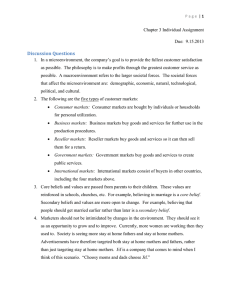
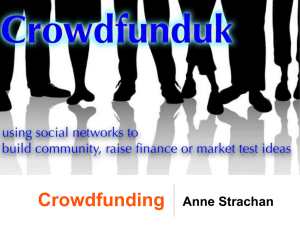
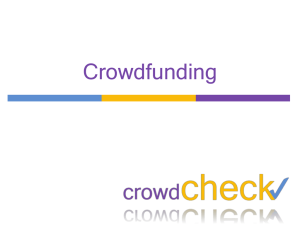
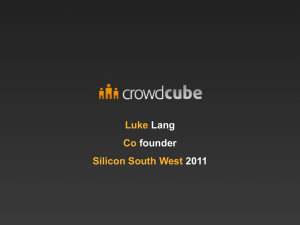
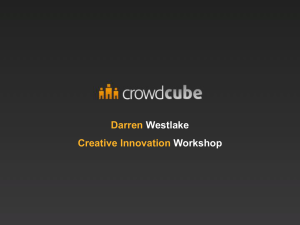
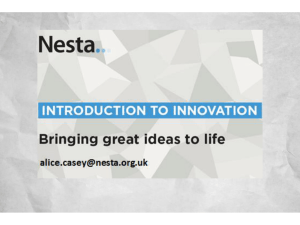
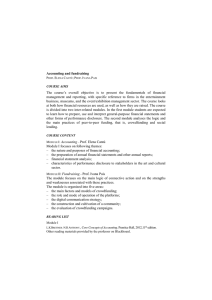
![[THIS SPACE MUST BE KEPT BLANK] Grassroots Innovation and Collaboration through Enterprise Crowdfunding](http://s2.studylib.net/store/data/013894189_1-14409bcbcdfd37c6e06f221441c5b4d1-300x300.png)